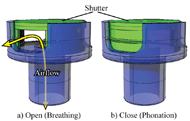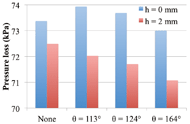Shape optimization of electrical control-type speaking valve controlled by neck myoelectric signal
Katsutoshi Oe, Kohei Sakurai
Department of Mechanical Systems Engineering, Daiichi Institute of Technology, JAPANABstract
We aimed to develop welfare devices for patients with phonation disorder. One of these devices is the electrical control-type speaking valve system. The conventional speaking valves have one-way valve architecture, they open when the user breathes in, and they close when user breathes out and produce voices. This type is very simple and tough, but some users feel closeness in case of exhalation without phonation. This problem is caused by its mechanism what can not be controlled by user’s will. Therefore, we proposed an electrical control-type speaking valve system to resolve this problem. This valve is controlled by neck myoelectric signal of sternohyoid muscle. From our previous report, it was clarified that this valve had better performance about easy-to-breath. Furthermore, we proposed the compact myoelectric control-type speaking valve system. The new-type speaking valve was enough small to attach the human body, and its opening area is larger than that of conventional one. In this report, we described the improvement of flow channel shape by using of FEM analysis. According to the result of the analysis, it was clarified that the shape-improved speaking valve gets the low flow resistance channel.
Background


We choose the controllable speaking valve as one of the above-mentioned welfare devices. In our previous research, it was clarified that this valve led the easy breathing (Oe, 2014). However, this valve had disadvantages about its size and weight.
Therefore, we aimed to develop the compact speaking valve system. Figure 1 shows the schematic diagram of proposed speaking valve. In this report, the development of the new speaking valve is described. In addition, the optimization of flow channel shape by FEM analysis for reduction of the flow resistance inside the valve is reported.
COnventional speaking valve
The mechanism of conventional speaking valve is one-way valve with a thin plastic plate. When the valve is closed, the exhalation loses its outlet port at tracheostoma and it must pass through the narrowed trachea by cannula. Additionally, the airway of open phase, during inspiration, is very narrow and complicated shape. Therefore, its flow resistance is high. As the result, the user becomes feel choking.

new type speaking valve system
Concept of new type speaking valve
The first reason of these problems is that user can’t control open/close of the valve by user’s will. However, this was cleared by using of our myoelectrical control unit (Oe, 2014), but the prototype valve was too big and heavy to carry on. We decided the compact speaking valve shown in figure 3. The dimension of this valve is as follows: diameter: 27mm, height without actuator: 11mm.
Optimization of flow channel

To estimate the effectiveness of these components, the pressure loss between inlet and outlet were calculated from the results of FEM analysis.
results

conclusion
The prototype neck myoelectrical control-type speaking valve was proposed. In this report, the downsized and shape optimized valve were described. This speaking valve has larger opening area than that of the conventional one, and it has simple shape flow channel. In addition, the applicable current plates made the reduction of pressure loss between inlet and outlet, their effectiveness were verified.References
Ooe, K., Tercero, C.R. & Fukuda, T. (2010). Development of the artificial larynx with neck EMG signal control, Proceedings of 2010 International Symposium on Micro-NanoMechatronics and Human Science (pp. 127-132). Nagoya.
Ooe, K. and Kishimoto, R. & Hashimoto, Y. (2013). Myoelectric control method for controllable electrolarynx, Proceedings of IEEE SENSORS 2013 (pp. 1262-1265). Baltimore, MD.
Oe, K. (2014). Proposal of electrical control-type speaking valve system controlled by neck myoelectric, Proceedings of the RESNA 2014, Indianapolis, IN: RESNA Press.
Acknowledgements
A part of this research was performed within JSPS KAKENHI grant number 23500648 and 26350685.